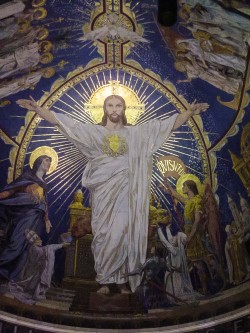
An excerpt of our FREE online Bible Study
‘He Must Reign’: The Kingdom of God in Scripture
Course Description
The drama in the Gospels turns on a single question: Is Jesus the long awaited Messiah, the son of David come to restore the everlasting monarchy promised to David? Underlying this drama are centuries of rival interpretations of the Jewish Scriptures and competing expectations of who the Messiah was to be, the signs that would accompany his coming, and the shape of the kingdom he would establish.
We explore all these issues in this thematic survey course, which goes to the heart of what the New Testament has to say about the identity of Christ and the Church.
I. David’s Covenant in Context
A. David and Moses

The drama in the Gospels turns on a single question: Is Jesus the long awaited Messiah, the son of David come to restore the everlasting monarchy promised by God to David?
Underlying this drama – which continues through the Acts of the Apostles and the Epistles and even into the final chapters of Revelation – are centuries of rival interpretations of the Scriptures.
In the Bible and in religious writing outside the Bible, we can see that there were sharply competing expectations about who the Messiah was to be, the “signs” that would accompany his coming, and the shape of the kingdom he would establish.
Through a close reading of the New Testament and key Old Testament passages, we will look at this clash of expectations. We will explore the biblical testimony in context, comparing it with the extra-biblical literature of the period, including the Dead Sea Scrolls and various intratestamental writings. We will see how the proclamation and work of Jesus, as recorded in the New Testament, reflects and reacts to the messianic hopes of his contemporaries.
This study has implications for questions that modern scholars have long debated – How did Jesus understand His mission and work? What were the historical reasons for his condemnation and death on the Cross?
This study also addresses an imbalance in the scholarly and pastoral study of the New Testament. Researchers have tended to focus on the importance and influence of Moses and the covenant at Sinai on the shape of the New Testament. By contrast there has been a relative scholarly neglect of the Davidic covenant.
However, it could be argued that the figure of David and his kingdom is more central – not only to the New Testament – but to the direction and meaning of the Old Testament.
David is generally acknowledged as a defining figure in the Psalms, with more than 70 psalms attributed to him. What is not widely recognized is his prominence throughout the Old Testament.
Indeed, while the name Moses occurs a little over 720 times, David is mentioned almost 1,020 times. David’s career is the subject of 42 chapters, or nearly 30 percent of what scholars call the “Deuteronomistic History” (Joshua-2 Kings).
In the Chronicles, a review of Israel’s history from a “Priestly” perspective, the percentage is the same.
David is mentioned 37 times in the prophets, Moses only seven times. And as we will focus on in our next lesson, the eschatological hopes of the prophets are frequently concerned with the return of a Davidic king and the restoration of his capital, Zion. The prophets say nothing about the return of Moses and a restoration of Sinai.
David’s imprint will be especially felt when we consider key Old Testament concepts and institutions that become central in the New Testament – the Temple, Zion, the “Son of God,” and the “Anointed One” (Messiah).
Click Here to continue the Bible Study